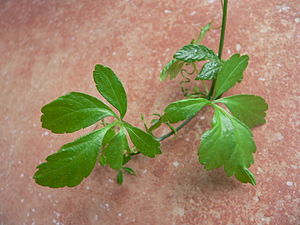Note: This is a project under development. The articles on this wiki are just being initiated and broadly incomplete. You can Help creating new pages.
Gynostemma pentaphyllum - Jiaogulan
Jiaogulan also called Gynostemma pentaphyllum literally "stranded blue plant", is a dioecious, herbaceous climbing vine of the family Cucurbitaceae (cucumber or gourd family) indigenous to the southern reaches of China, northern Vietnam, southern Korea, and Japan. Jiaogulan is best known as an herbal medicine reputed to have powerful antioxidant and adaptogenic effects purported to increase longevity.
Uses
blood sugar, cholesterol, blood pressure, nervous tension, peptic ulcer, asthma, bronchitis, diabetes, cardiovascular, cancer
Parts Used
Chemical Composition
Contains volatile oils, flavonoids, apigenin, luteolin, quercetin, kaempferol, tiliroside, triterpene glycosides including euscapic acid and tormentic acid, phenolic acids, and 3%–21% tannins.[1]
Common names
| Language | Common name |
|---|---|
| Kannada | |
| Hindi | |
| Malayalam | |
| Tamil | |
| Telugu | |
| Marathi | NA |
| Gujarathi | NA |
| Punjabi | NA |
| Kashmiri | NA |
| Sanskrit | |
| English | Agrimony |
Properties
Reference: Dravya - Substance, Rasa - Taste, Guna - Qualities, Veerya - Potency, Vipaka - Post-digesion effect, Karma - Pharmacological activity, Prabhava - Therepeutics.
Dravya
Rasa
Guna
Veerya
Vipaka
Karma
Prabhava
Habit
Identification
Leaf
| Kind | Shape | Feature |
|---|---|---|
| Simple | The leaves are divided into 3-6 toothed leaflets, with smaller leaflets in between |
Flower
| Type | Size | Color and composition | Stamen | More information |
|---|---|---|---|---|
| Unisexual | 2-4cm long | Yellow | 5-20 | Flowers Season is June - August |
Fruit
| Type | Size | Mass | Appearance | Seeds | More information |
|---|---|---|---|---|---|
| 7–10 mm (0.28–0.4 in.) long pome | clearly grooved lengthwise, Lowest hooked hairs aligned towards crown | With hooked hairs | {{{6}}} |
Other features
List of Ayurvedic medicine in which the herb is used
- Vishatinduka Taila as root juice extract
Where to get the saplings
Mode of Propagation
How to plant/cultivate
Requires a rich well-drained but moisture-retentive soil in a warm sheltered position in partial shade[3]
Commonly seen growing in areas
Photo Gallery
References
External Links
- Pages that are stubs
- Ayurvedic Herbs known to be helpful to treat blood sugar
- Ayurvedic Herbs known to be helpful to treat cholesterol
- Ayurvedic Herbs known to be helpful to treat blood pressure
- Ayurvedic Herbs known to be helpful to treat nervous tension
- Ayurvedic Herbs known to be helpful to treat peptic ulcer
- Ayurvedic Herbs known to be helpful to treat asthma
- Ayurvedic Herbs known to be helpful to treat bronchitis
- Ayurvedic Herbs known to be helpful to treat diabetes
- Ayurvedic Herbs known to be helpful to treat cardiovascular
- Ayurvedic Herbs known to be helpful to treat cancer
- Herbs with Leaves used in medicine
- Herbs with Stems used in medicine
- Herbs with common name in English
- Habit - Herb
- Index of Plants which can be propagated by Seeds
- Herbs that are commonly seen in the region of Tall grasslands
- Herbs that are commonly seen in the region of meadows
- Herbs that are commonly seen in the region of Borders of forests and fields
- Herbs
